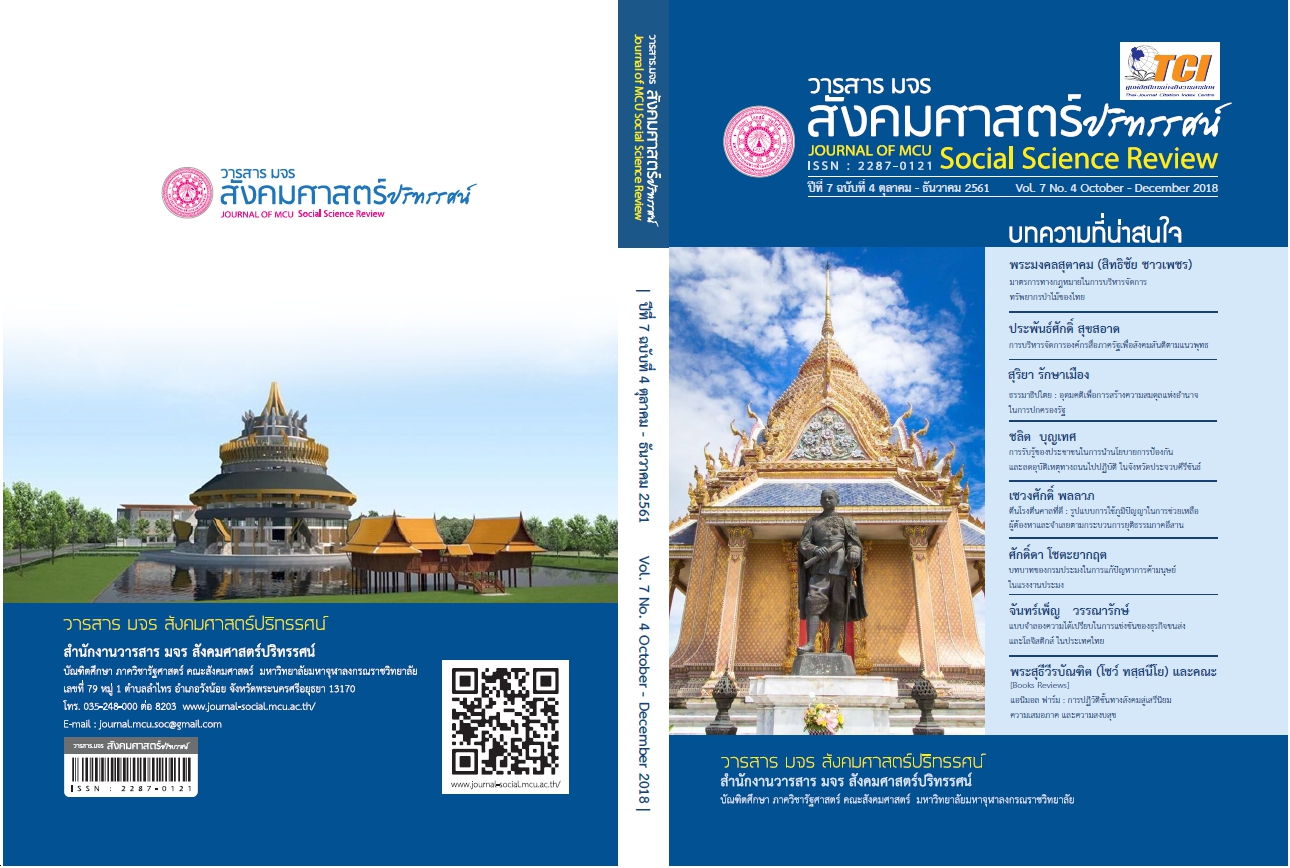รูปแบบการจัดการการสื่อสารเพื่อพัฒนาการเผยแผ่พระพุทธศาสนา ของพระสงฆ์ในจังหวัดนครปฐม
คำสำคัญ:
รูปแบบการจัดการการสื่อสาร, การเผยแผ่พระพุทธศาสนา, พระสงฆ์บทคัดย่อ
บทความนี้มีวัตถุประสงค์ 1) เพื่อศึกษาสภาพทั่วไปและปัญหาอุปสรรคการจัดการการสื่อสารเพื่อพัฒนาการเผยแผ่พระพุทธศาสนาของพระสงฆ์ในจังหวัดนครปฐม 2) เพื่อศึกษาทฤษฎีการจัดการการสื่อสารและหลักพุทธธรรมเพื่อพัฒนาการเผยแผ่พระพุทธศาสนา 3) เพื่อเสนอรูปแบบการจัดการการสื่อสารเพื่อพัฒนาการเผยแผ่พระพุทธศาสนาของพระสงฆ์ในจังหวัดนครปฐม ระเบียบวิธีวิจัยเป็นแบบผสานวิธี (Mixed Methods Research) การวิจัยเชิงคุณภาพโดยการเก็บข้อมูลจากการสัมภาษณ์เชิงลึกจากผู้ให้ข้อมูลสำคัญ จำนวน 19 รูป/คน ด้วยแบบสัมภาษณ์เชิงลึกที่มีโครงสร้าง วิเคราะห์ข้อมูลด้วยการพรรณนาความ การวิจัยเชิงปริมาณกำหนดกลุ่มตัวอย่างจากพระสงฆ์ในเขตพื้นที่จังหวัดนครปฐมจำนวน 359 รูป เก็บข้อมูลด้วยแบบสอบถามแบบประมาณค่า 5 ระดับ มีค่าความเชื่อมั่นเท่ากับ 0.95 วิเคราะห์ข้อมูลด้วยสถิติ ค่าความถี่ ค่าร้อยละ ค่าเฉลี่ย ส่วนเบี่ยงเบนมาตรฐาน
ผลการวิจัยพบว่า 1. สภาพทั่วไปและปัญหาอุปสรรคการจัดการการสื่อสารเพื่อพัฒนาการเผยแผ่พระพุทธศาสนาของพระสงฆ์ในจังหวัดนครปฐม พระสงฆ์ทุกระดับให้ความสำคัญกับการเผยแผ่พุทธศาสนาโดยมีความร่วมมือกับองค์กรหน่วยงานทั้งภาครัฐและเอกชนมีการตั้งคณะทำงานมีหน้าที่ในการกำหนดขั้นตอนการปฏิบัติงานกำหนดกลยุทธ์ต่างๆที่ชัดเจน มีกลยุทธ์ในการทำงานเชิงรุกและเชิงรับ ในส่วนของปัญหาอุปสรรคสาเหตุมาจากการจัดการการสื่อสารทั้ง 4 ด้าน คือ ผู้ส่งสารขาดการตรวจสอบขีดความสามารถของบุคลากร ด้านสารที่พระสงฆ์ใช้เป็นวิชาการทางธรรมมากเกินไป ด้านช่องทางสื่อสาร/สื่อพระสงฆ์ยังขาดความชำนาญในการใช้ให้เกิดประสิทธิภาพ ด้านผู้รับสารประชาชนไม่มีเวลาเข้าวัด
2. ทฤษฎีการจัดการการสื่อสารและหลักพุทธธรรมเพื่อพัฒนาการเผยแผ่พระพุทธศาสนา ได้แก่ ทฤษฎีการจัดการการสื่อสารประกอบด้วย 4 องค์ประกอบ คือ 1) ผู้ส่งสาร 2) สาร 3) ช่องทางสื่อสาร/สื่อ 4) ผู้รับสาร บูรณาการด้วยหลักพุทธธรรม ได้แก่ หลักภาวนา 4 คือ 1) กายภาวนา 2) ศีลภาวนา 3) จิตภาวนา 4) ปัญญาภาวนา การประยุกต์ใช้จะช่วยส่งเสริมพัฒนาการเผยแผ่พระพุทธศาสนาของพระสงฆ์ให้เกิดประสิทธิภาพเพิ่มมากยิ่งขึ้น 3. รูปแบบการจัดการการสื่อสารเพื่อพัฒนาการเผยแผ่พระพุทธศาสนาของพระสงฆ์ในจังหวัดนครปฐม 1) ผู้ส่งสาร ต้องฝึกฝนจริยวัตรให้งดงามเคร่งครัดในศีลบริบูรณ์ในศีลฝึกฝนกำกับจิตใจให้สงบมีพลังจิตที่เข้มแข็งคิดอย่างแยบคายแก้ปัญหาได้คิดพัฒนาประยุกต์สร้างสรรค์ได้2) สาร เผยแผ่หลักภาวนา 4 ให้ประชาชนนำไปประพฤติปฏิบัติส่งเสริมความเคร่งครัดในกฎระเบียบวินัยกฎหมายสามารถพัฒนาฝึกฝนจิตใจตนเองใช้หลักภาวนา 4 สอนให้คนใช้สติปัญญาในการดำเนินชีวิต 3) ช่องทางสื่อสาร/สื่อ ใช้สื่อที่สามารถสื่อภาพลักษณ์ภาวนา 4 ประยุกต์ให้เหมาะสมกับการปฏิบัติให้เข้าถึงภาวนา 4 สร้างความสนใจต่อหลักภาวนา 4 สร้างความเข้าใจหลักภาวนา 4 และการปฏิบัติตาม 4) ผู้รับสาร สอนให้เข้าใจเข้าถึงกระบวนการฝึกฝนภาวนา 4 เผยแผ่ภาวนา 4 ให้ตรงกับจริต เผยแผ่ภาวนา 4 ตามระดับกลุ่มอายุกลุ่มอาชีพ พิจารณาความพร้อมของผู้รับเนื้อหาของภาวนา 4
เอกสารอ้างอิง
Winston Inc,
Kullaporn Hongthong. (2010). The Study in Effectiveness of Information Media That Effectiveness The Student to Recept and Motivate The Interest for Continuing Rajamanagla University of Technology Rattanakosin
(Research Report). Bangkok: Rajamanagla University of Technology Rattanakosin.
Phramaha Taruti Rungchaiwithun. (2014). Pattern of Human Resource Development of Sangha Administrators for Efficiency of Sangha Administration. Dissertation Graduate School: Mahachulalongkornrajavidyalaya University.
Suphangpim Klaythanee. (2014). The Development of Communicative Leadership in Line With Buddhism. Dissertation Graduate School: Mahachulalongkorn-
rajavidyalaya University.
Tatsanee Jenwithisuk. (2011). The Buddhist Communication and The Social Change. Dissertation Graduate School: Mahachulalongkornrajavidyalaya University.
Yamane, Taro. (1967). Elementary Sampling Theory. Englewood Cliffs. New Jersey: Prentice-Hall.
ดาวน์โหลด
เผยแพร่แล้ว
รูปแบบการอ้างอิง
ฉบับ
ประเภทบทความ
สัญญาอนุญาต
ลิขสิทธิ์ (c) 2019 วารสาร มจร สังคมศาสตร์ปริทรรศน์

อนุญาตภายใต้เงื่อนไข Creative Commons Attribution-NonCommercial-NoDerivatives 4.0 International License.
เพื่อให้เป็นไปตามกฎหมายลิขสิทธิ์ ผู้นิพนธ์ทุกท่านต้องลงลายมือชื่อในแบบฟอร์มใบมอบลิขสิทธิ์บทความให้แก่วารสารฯ พร้อมกับบทความต้นฉบับที่ได้แก้ไขครั้งสุดท้าย นอกจากนี้ ผู้นิพนธ์ทุกท่านต้องยืนยันว่าบทความต้นฉบับที่ส่งมาตีพิมพ์นั้น ได้ส่งมาตีพิมพ์เฉพาะในวารสาร มจร สังคมศาสตร์ปริทรรศน์ เพียงแห่งเดียวเท่านั้น หากมีการใช้ภาพหรือตารางหรือเนื้อหาอื่นๆ ของผู้นิพนธ์อื่นที่ปรากฏในสิ่งตีพิมพ์อื่นมาแล้ว ผู้นิพนธ์ต้องขออนุญาตเจ้าของลิขสิทธิ์ก่อน พร้อมทั้งแสดงหนังสือที่ได้รับการยินยอมต่อบรรณาธิการ ก่อนที่บทความจะได้รับการตีพิมพ์ หากไม่เป็นไปตามข้อกำหนดเบื้องต้น ทางวารสารจะถอดบทความของท่านออกโดยไม่มีข้อยกเว้นใดๆ ทั้งสิ้น





